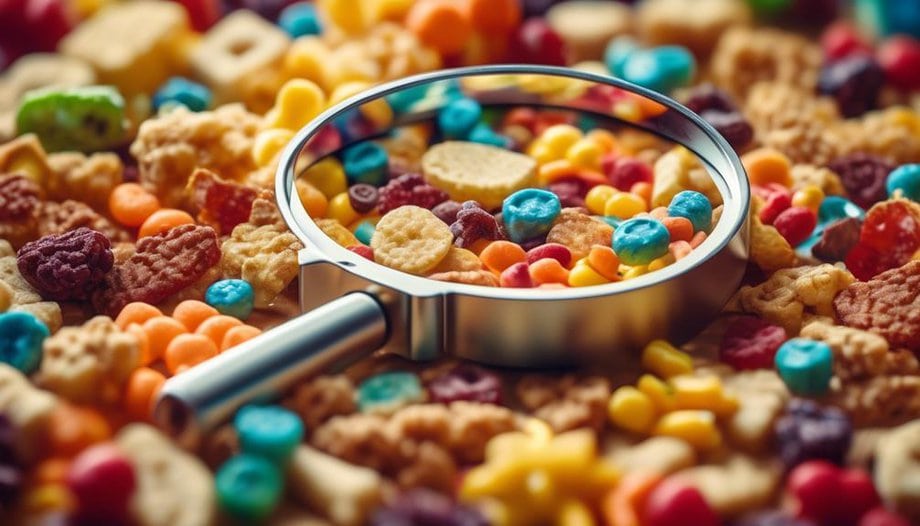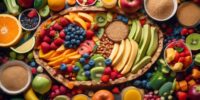How to Find Out About Hidden Sugars in Children's Diets

Hidden sugars can be found in a variety of foods and beverages. They can have a significant impact on your child's health. Learn how to find and avoid these sneaky sugars. This will ensure your child's diet is free from harmful sweeteners.
The Impact of Hidden Sugars on Children's Health
Hidden sugars in children's diets can have a significant impact on their overall health and well-being. It's crucial to be aware of the hidden sugars present in various foods that kids consume regularly. Sugar can be found in unexpected places and may not resemble the typical powdered form that we associate with sweetness. Therefore, it's important to read food labels carefully to uncover the hidden sugar content in different products.
Common foods that may contain hidden sugars include sports drinks, 100% juice drinks, breads, and flavored milks. These seemingly healthy options can actually contribute a considerable amount of sugar to a child's diet. For instance, a sports drink can contain up to 21 grams of sugar per serving, while a flavored milk can have around 15 grams of sugar. These numbers may not seem alarming, but when combined with other sources of hidden sugars, they can add up quickly.
The impact of hidden sugars on children's health shouldn't be underestimated. Excessive sugar intake can lead to childhood obesity, type II diabetes, and other chronic conditions. By reducing the consumption of hidden sugars, parents can help their children maintain a healthy diet and prevent these health issues. Strategies such as diluting sugary beverages, choosing whole wheat options, and opting for plain yogurt with fresh fruit can make a significant difference in reducing hidden sugar intake.
Identifying Common Sources of Hidden Sugars
Now that you understand the impact of hidden sugars on children's health, it is important to identify the common sources of hidden sugars in order to make informed choices about your child's diet. Reading food labels is necessary to identify hidden sugars. Common sources of hidden sugars include sports drinks, energy drinks, and 100% juice drinks. These beverages may appear healthy, but they often contain high amounts of added sugars. To give you a clearer picture, here is a table showcasing some common sources of hidden sugars:
| Food/Drink | Hidden Sugars (teaspoons) |
|---|---|
| Flavored Yogurt | 4-6 teaspoons |
| Juice Drinks | 7-10 teaspoons |
| Flavored Cereals | 3-5 teaspoons |
As you can see, seemingly innocent foods like flavored yogurt and juice drinks can contain a significant amount of hidden sugars. To reduce your child's intake of hidden sugars, consider opting for plain yogurt and diluting juice drinks with water. Additionally, choosing whole wheat breads and cereals over their sugary counterparts can also help reduce hidden sugar consumption. By being aware of these common sources of hidden sugars, you can make healthier choices for your child's diet and reduce their risk of weight gain and chronic diseases.
Reading Food Labels for Hidden Sugars
When it comes to reading food labels for hidden sugars, it's important to be aware of sugar aliases that manufacturers may use to disguise added sugars. Ingredients like high fructose corn syrup, maltose, and dextrose are all examples of sugar aliases to look out for.
Sugar Aliases on Labels
Reading food labels is essential for identifying hidden sugars in children's diets. It's important to be aware of the various sugar aliases that may appear on labels, as they can be misleading.
Here are some sugar aliases to watch out for:
- High fructose corn syrup: This is a common sweetener that's used in many processed foods and beverages. It has a high grams of sugar per serving and can contribute to obesity and other health problems.
- Dextrose: This is another name for glucose, which is a type of sugar. It's often used as a sweetener in packaged foods and can add to the overall sugar content.
- Sucrose: This is table sugar, which is a combination of glucose and fructose. It's commonly used in baked goods and can have a much more detrimental effect on health when consumed in excess.
Identifying Added Sugars
To effectively identify hidden sugars in food products, it is essential to carefully read and analyze food labels. By understanding how to interpret the information provided, you can make informed choices for you and your children. Here is a table to help you compare sugar content in different food items:
| Food Product | Sugar Content (per serving) | Recommended Daily Intake |
|---|---|---|
| Soft drinks | 35-40 grams | Exceeds intake |
| Orange juice | 35-40 grams | Exceeds intake |
| Sports drinks | Varies | Limit intake |
| Energy drinks | Varies | Limit intake |
| Flavored yogurts | Varies | Choose plain options |
Remember to compare apples to apples when comparing sugar content. Look for substitutes or zero sugar options wherever possible. For example, instead of flavored yogurts, opt for plain yogurt and add a small amount of sugar or fresh fruit. By being mindful of added sugars, you can help your children maintain a healthy weight and improve overall health with less negative effects.
Strategies for Reducing Hidden Sugars in Children's Diets
Reducing hidden sugars in children's diets requires implementing evidence-based strategies that promote awareness and empower parents to make informed decisions about their children's sugar intake. To achieve this, there are several strategies that can be employed:
- Education and Awareness:
- Provide education to parents about the sources and effects of hidden sugars in children's diets.
- Raise awareness about the importance of reading food labels to identify hidden sugars.
- Offer resources and tools, such as online guides or mobile applications, to help parents find out the hidden sugars in children's diets.
- Healthy Substitutions:
- Encourage parents to choose healthier alternatives to sugary foods and beverages, such as fruits instead of processed snacks or water instead of sugary drinks.
- Promote the consumption of whole foods and home-cooked meals, as they're less likely to contain hidden sugars.
The Truth About Sugar Substitutes for Kids
Now let's discuss the truth about sugar substitutes for kids.
While sugar substitutes can help reduce high-fructose corn syrup intake, it's important to be aware of their potential harmful effects.
Some substitutes, such as artificial sweeteners, have been linked to negative health outcomes, including weight gain and increased risk of chronic diseases.
It's crucial to carefully choose healthier alternatives and educate children about moderation and the importance of a balanced diet.
Harmful Effects of Substitutes
Sugar substitutes can have both advantages and disadvantages for children's health, and it's important to understand the potential harmful effects they can have on their well-being. Here are some key points to consider:
- Artificial sweeteners may lead to an increased insulin response in children, which can disrupt their metabolism and potentially contribute to weight gain and obesity.
- Studies have also suggested a possible link between artificial sweeteners and an increased risk for cancer in children.
Transitioning to artificial sweeteners can reduce the intake of high-fructose corn syrup, a common sweetener associated with various health issues.
- However, it's worth noting that synthetic sugar substitutes metabolize differently in the body, and avoiding synthetic substances is generally considered healthier for children.
Instead of artificial sweeteners, small amounts of honey can be used to improve the taste of foods that are already sweet, such as adding a teaspoon to a drink or orange juice.
Hidden Sugars in Substitutes
To further explore the impact of sugar substitutes on children's diets, let's shed light on the hidden sugars present in these alternatives. Sugar substitutes are often used as a way to reduce the amount of added sugar in children's diets. However, it's important to note that not all sugar substitutes are created equal.
Some artificial sweeteners, such as aspartame and sucralose, may be used in flavored water options or sparkling water options marketed towards children. While these beverages may seem like a healthier choice, they can still contain hidden sugars.
Additionally, yogurt options and adding fruit or small amounts of honey to unprocessed foods can also contribute to hidden sugars in children's diets. Therefore, it's crucial to read food labels carefully and opt for unprocessed foods whenever possible to minimize the intake of hidden sugars.
Choosing Healthier Alternatives
Choosing healthier alternatives for sugar substitutes is essential when it comes to managing children's sugar intake. By making smart choices, you can reduce the amount of hidden sugars in their diets and contribute to their improved health. Here are two key strategies to consider:
- Choose unprocessed foods: Opt for whole, unprocessed foods that are naturally low in sugar. Fruits, vegetables, lean proteins, and whole grains are excellent options that provide essential nutrients without added sugars.
- Control portion sizes: Be mindful of portion sizes when serving foods that contain natural sugars. While fruits are a healthy choice, it's important to moderate the amount to avoid excessive sugar intake. Additionally, consider using artificial sweeteners sparingly, as they can be a suitable alternative for reducing sugar content without sacrificing taste.
Educating Children on Hidden Sugars
Are you aware of the hidden sugars lurking in your child's diet? Educating children about hidden sugars is crucial in promoting improved health and reducing their intake. Hidden sugars aren't easily recognizable, making it difficult to estimate daily sugar intake accurately. However, by teaching children about common foods fortified with hidden sugars and the importance of reading food labels, they can make informed choices.
Children should aim for no more than 6 teaspoons of sugar daily, but common sources like soft drinks and orange juice can easily exceed this limit. By educating children about the sugar content in these beverages, they can make healthier choices. Encouraging them to dilute sugary drinks or choose alternatives like water or unsweetened beverages can make a significant difference.
It is also important to educate children about choosing whole wheat options over refined grains. Whole wheat products contain more fiber and fewer hidden sugars. Additionally, opting for plain yogurt with added fresh fruit or small amounts of honey can be a healthier alternative compared to flavored yogurts that are often high in added sugars.
Parents, healthcare providers, and society as a whole play a crucial role in educating children about hidden sugars. By promoting a shift towards a healthier diet and making it easier to choose whole natural foods over processed convenience foods, we can empower children to make healthier choices and improve their overall health.
Creating a Healthy Sugar-Free Environment for Kids
How can we create a sugar-free environment that promotes the health and well-being of children? By implementing a few key strategies, you can significantly reduce hidden sugars in your child's diet and create a healthy environment that supports their improved health. Here's what you can do:
- Identify and eliminate hidden sugars: Be vigilant about reading food labels and identifying common foods with hidden sugars such as sports drinks, 100% juice drinks, and flavored milks. By reducing or eliminating these items from your child's diet, you're taking a significant step towards reducing their sugar intake.
- Choose unprocessed foods: Opt for whole, unprocessed foods whenever possible. These foods are less likely to contain added sugars and provide essential nutrients for your child's growth and development.
- Add sugar substitutes: Consider using natural sugar substitutes like stevia or monk fruit to sweeten foods and beverages. These alternatives can provide sweetness without the negative health effects associated with excessive sugar consumption.
- Explore artificial sweeteners: Artificial sweeteners can be an option for reducing sugar intake, but it's important to use them in moderation and consult with a healthcare professional if you have any concerns.
Frequently Asked Questions
How Do You Identify Hidden Sugars?
To identify hidden sugars, start reading food labels. Look for sugar alternatives and natural sweeteners. Choose sugar-free snacks and reduce added sugars in processed foods. Be aware of sugar in beverages, breakfast cereals, and condiments. Consider healthy dessert options.
What Are the 7 Hidden Sugars?
Hidden sugars can be found in sports drinks, energy drinks, 100% juice drinks, breads, cereals, flavored milks, breakfast foods, pasta sauces, granola bars, yogurt, and instant oatmeal. Be cautious and read food labels.
What Are 5 Examples of High Sugar Foods That Children Should Avoid?
To avoid high sugar foods, you should steer clear of soft drinks, orange juice, sports drinks, energy drinks, and flavored yogurts. Opt for healthy alternatives, sugar-free snacks, and balanced meal planning. Educate parents about the impact of sugary drinks and the importance of reading food labels. Limit dessert consumption for better dental health.
What Food Contributes the Most Sugar in Children's Diets?
The food that contributes the most sugar in children's diets is often hidden in common foods like sports drinks, juice drinks, breads, cereals, yogurts, and flavored milks. It's important to read food labels to identify hidden sugars and find sugar-free alternatives for snacks.











